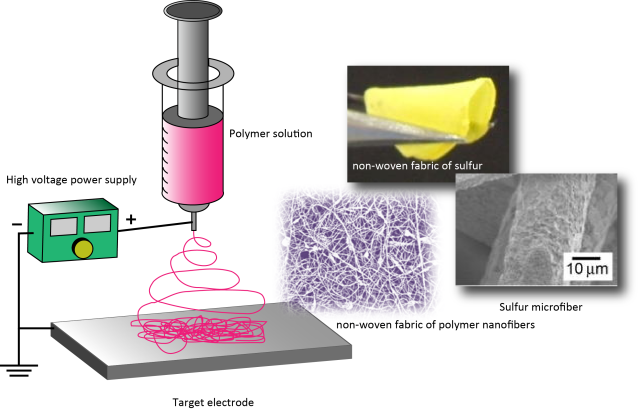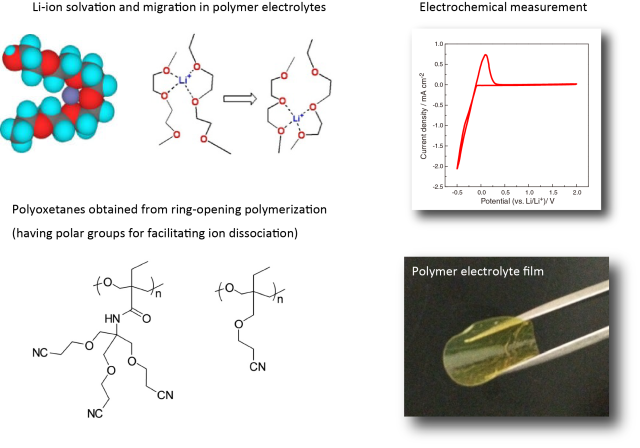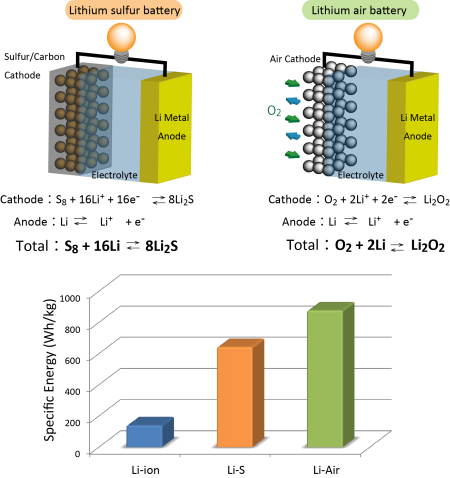Research Projects
Research Objective
The final goal of our group is to develop a functional material based on
polymeric or organic-inorganic hybrid materials that would be useful in
realizing our sustainable society. Our focus is to not only synthesize
a new chemical compound but also fabricate an innovative material by modifying
shape/dimension or by combining the materials even with known materials.
Our procedure for conducting research includes careful preparation and detailed characterization of the functional materials, and further material evaluation for applications. We hope this will help our students to learn a broad range of experimental techniques such as organic (polymer) synthesis, electrochemical measurements, and other specific measurements for applications.
Recent Topics
Functional nanofibers by electrospinning
Electrospinning method allows us to draw micro- and submicron-scaled fine
fibers from polymer solutions. With this technique, functional nanofibers
and their non-woven fabric of various synthetic polymers have been prepared
in our group. In addition to the polymeric fibers, we found that elemental
sulfur can also be electro-spun into a fine fiber in the high temperature
melt (see below). We are currently trying to use this sulfur fiber as electrode
material for lithium sulfur battery. Our interest in this filed also includes
preparation of nanofibers/non-woven fabrics of biocompatible polymers for
bio-medical applications.

(References)
H. Tsutsumi et al., ECS Trans., 35, 49 (2011).
S. Hosogai et al., J. Power Sources, 194, 1213 (2009).
Metal and metal oxide nanotubes and its applications
In combination with non-electric plating method, metal and metal oxide
nanotubes can be obtained from the polymeric nanofibers as template. These
metal and metaloxide nanotubes have attracted attention as electrodes for
batteries, catalyst, material transport, and separation. We have synthesized
various nanotubes from polymer and sulfur fibers as shown below.

(References)
H. Nakamoto et al. Materials Letters, 136, 26 (2014).
町田ら,表面技術, 60, 357 (2009).
Solid polymer electrolytes for lithium secondary batteries
Organic electrolytes used in lithium ion batteries have high volatility and flammability that raise a serious safety issue for their use in the large scale energy storages such as electric vehicles and stationary type secondary batteries. Our group studies nonflammable polymer electrolytes which can be an alternative to the flammable liquid electrolytes. The polymer electrolytes enable to avoid the electrolyte leakage and to fabricate light and thin battery packs. One of the problems of the polymer electrolytes is their low conductivity at ambient temperature. We are trying to improve the conductivity by novel molecular design of polymer structure as shown below.
(References)
Y. Nakano et al. Solid State Ionics, 262, 774 (2014).
鈴木ら,高分子論文集, 70, 10 (2013).
R. Shibutani et al., Solid State Ionics, 202, 369 (2012).
R. Kido et al. Electrochim. Acta, ASAP (2015). DOI: 10.1016/j.electacta.2015.01.067
Novel electrode materials and liquid electrolytes for high energy density batteries
Growing demand for electrical and hybrid vehicles and stationary energy storage requires the development of “beyond Li-ion batteries” with high energy density exceeding that of the state-of-the-art Li-ion batteries. Among the prospective alternatives proposed so far, we are interested in lithium-sulfur, lithium-air, and magnesium batteries. To realize the practical use of these batteries, further breakthroughs in design of electrode materials and electrolytes are necessary. Our recent projects in this topic involve (1) novel sulfur-based cathode material, (2) new Mg electrolytes, (3) ionic liquid-based electrolytes for lithium-sulfur and lithium-air batteries, (4) optimization of catholyte for lithium-sulfur cell, (5) mesoporous carbon nanofibers for sulfur-host/current collector, (6) protecting layer for lithium metal anode.


(References)
K. Ueno et al. J. Phys. Chem. C, 117, 20509 (2013).
K. Ueno et al. Phys. Chem. Chem. Phys., 17, 8248 (2015).
Hiromori Tsutsumi's Lab.
(Energy and Functional Materials)
Graduae School of Sciences and Technology for Innovation,
Faculty of Engineering, Applied Chemistry, Yamaguchi University
Faculty of Engineering Main Bulding Room 404 (Ube Campus)
2-16-1 Tokiwadai, Ube, Yamaguchi, Japan, 755-8611
TEL: +81-836-85-9282
FAX: +81-836-85-9201


